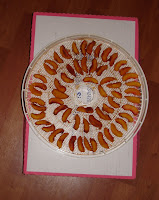
When one tree produces more than 300 peaches, you have to be creative on what to do with all of those peaches. I've dried or dehydrated tomatoes before and they were really good, so I thought I would try drying or dehydrating peaches. I got my dehydrator several years ago at a department store. I'm starting with about 16 medium sized peaches, juice from 4 limes, a small strainer, a mixing bowl filled with water, a cutting board, and a paring knife.

The peaches should be ripe, but firm. I washed the peaches off, just to get the dust off. I don't use any pesticides, so there is no unwanted residue in that category. I slice the peach in half and remove the pit. Then I slice the peach in half again and holding the peach quarter in my right hand, I take my left thumb and peel off the skin. I am growing Red Haven peaches. These peaches are wonderful because not only do they taste good, they have little to no fuzz, the skin peels off readily, and they are freestone, which means the pit can be removed very easily from the fruit. Cling peaches don't do this, which makes it hard to remove the pits for canning, drying or freezing.

Pour the lime juice, or you can use lemon juice, in the mixing bowl with the water. If you don't have any lemons or limes, you can use ascorbic acid found in the canning section of your local grocery store. I happened to be at the 99 cent store the other day and got a whole bag of Persian limes for, yes, just 99 cents. Make sure the stainer is submerged in the water when it is placed over the bowl. Now take the pitted and peeled peaches and slice them again which means they are now cut into eighths. When you get two peaches pitted, peeled and cut up, place them in the strainer and submerge into the citrus water for no longer than 5 minutes. Soaking the peaches in the citrus water prevents them from oxidizing in the air, turning brown and helps retain the vitamins. After soaking the peaches for a short time, drain the water over the bowl, letting most of the water fall back into the mixing bowl (for the next batch of peaches). Now arrange these peaches in rows on your dehydrator rack close together, but not touching. You want to leave a little space between each peach slice so the air can circulate around and dry them out. Now go back to pitting, peeling and slicing two more peaches and so on till you get all of your dehydrator racks filled.

Dehydrate on 135 F till dry. I put the peaches on at 11 am. You'll have to wait to see how long it takes them to dry. I also want check the electric meter to see how much energy dehydrating takes. The amount of time to dehydrate will vary depending upon the variety of the peach, how ripe and juicy it is, and the brand of dehydrator utilized. To be continued...













